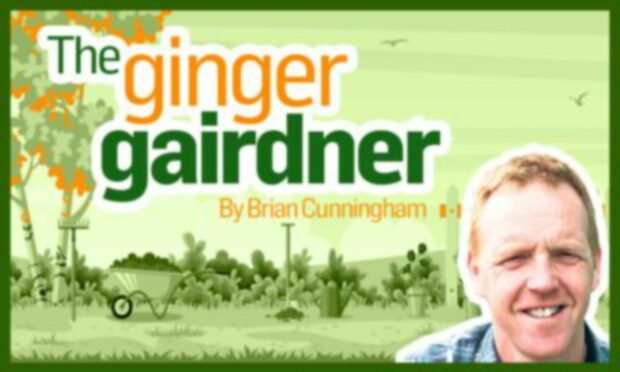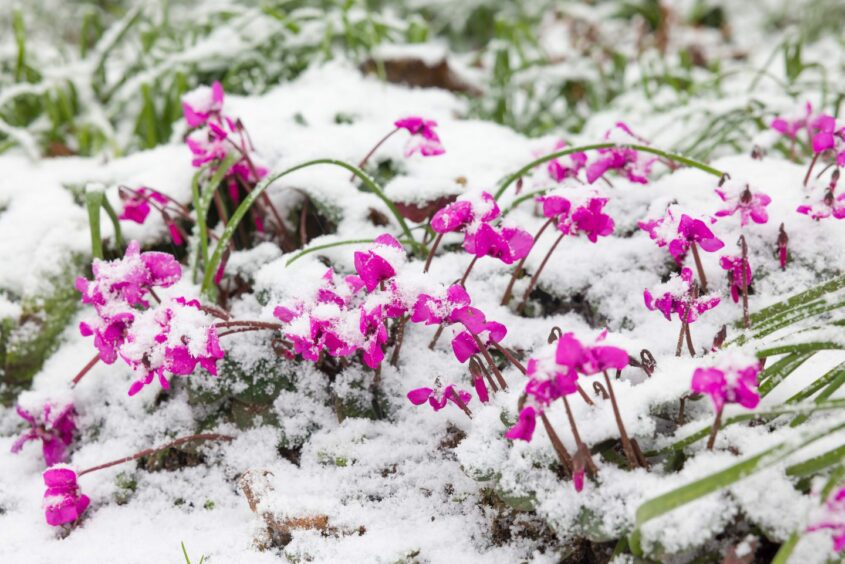I reckon I could do without a calendar these days, certainly to tell me what month it is anyway. I’m confident I can work this out by what plants are flowering in my garden.
For example just now with the sight of the flowers emerging from the ground of Cyclamen hederifolium, I know the season is changing, we’re heading into autumn and it’s the beginning of September.
Signature September
I find certain plants can be quite emotive, triggering feelings like this plant does to me, reminding me of days working with specialist bulbs in the alpine department of the Royal Botanical Gardens in Edinburgh.
The start of September is the signature moment in the cycle of our potted bulb display when we give them their first good drink, starting them into growth.
Many of the familiar bulbs we know grow naturally on the dry and sunny mountainsides of Southern Europe, Turkey and Mediterranean islands where, after a summer of drought, are replenished by the autumn rains.
It’s this way of nature that we try to replicate when we are growing bulbs in our glasshouses at home.
All happens underground
The likes of Narcissus, Iris and Fritillaria spend the next few months producing fresh roots underground and out of sight before the leaves appear late winter. The result is the pinnacle spring flowering display.
But this Ivy-leaved Cyclamen doesn’t want to wait and is producing flowers for us just now.
Only a few of the species Cyclamen grow in such hot and dry conditions; the likes of this popular Ivy-leaved Cyclamen prefers the dappled shade and cooler habitats of woodlands, growing in leafier soils.
Understanding how a plant grows in it’s natural environment can give us a clue how to grow them in our gardens at home.
They like a free draining soil and slot in well to an alpine garden. However, I think they look their best when grown under the canopies of deciduous shrubs and trees, thriving in the conditions they can be found growing in the wild.
It’s nodding flowers come in shades of pink, though there is a white form which when included together can make a display look more stunning.
Mixing it up
I’ve tried this myself underneath the purple foliage of a Norway Maple but the white form C, hederifolium f. Album always seem to come out that wee bit earlier.
I’m fine with it though as it just means the flowering display lasts that little bit longer.
To be fair you can’t really complain about getting your money’s worth with this plant; there are the leaves which come as the flowering period is coming to an end and some say are its main quality.
The foliage can seem unique, being very variable in size and shape, a marble effect being produced of green and silvery white or, if you’re lucky, the opposite way around.
A lot of important information can be extracted from the plant’s name.
If you know your Latin, the species half of its botanical title gives the most accurate description, hedera-ivy and folium-leaved, means its leaves resemble that of an Ivy.
The genus (Cyclamen) itself describes the plants rounded tubers.
The plant that keeps giving
It doesn’t stop here either. After flowering as it goes through the process of producing seed, the stem slowly coils itself back on itself and the seed pod opens, releasing the next generation of Cyclamen to the ground.
Here’s the fascinating part. The seed is covered in a sugary coating attractive to ants, who in reward for this sweet treat, help to disperse the seed to other parts of the garden.
Hopefully this may explain how that clump of Cyclamen growing at the edge of your woodland-themed garden has now started appearing in the gravel of your path.
The value of another species of Cyclamen is never more appreciated than C, coum flowering in late winter and at a time when colour is needed in our lives the most.
Lift winter spirits
This combines perfectly with other winter-flowering bulbs such as the yellow winter aconite and the white of snowdrops.
Lift your winter spirits even further by adding a Witch-hazel shrub, with it’s spidery flowers coming from the bare stems, releasing a scent that fills the cold air.
Those discussed are the two Cyclamen hardy enough for growing outdoors in our Scottish climate, but if you have the room there are others that can be cultivated under glass.
Scotland’s top bulb expert Ian Young regularly gives us the benefit of experience on the ways to grow these, and many other bulbs from around the world, which he does from his garden in Aberdeen.
Visit the website of the Scottish Rock Garden Club where he writes a weekly blog. Better still, become a member. You will not only receive a journal twice a year but also have access to the member’s seed exchange where you can have a go at specialising in bulbs yourself.



Conversation